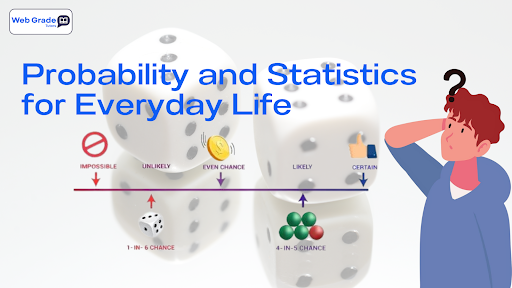Visit our website
Explore content tailored to your curriculum and country—from foundational skills to exam prep.
Explore ContentPlease add some widget in Offcanvs Sidebar

If you’ve heard “When will I ever use probability and statistics?” at the kitchen table, you’re not alone. Parents worry about exam performance and confidence; students worry that math feels abstract. The truth? We all use probability and statistics daily—deciding whether to carry an umbrella, comparing phone plans, interpreting sports stats, or reading health news.
In this easy-to-follow guide, you’ll learn:
Your child faces a question: “A bag has 4 red, 3 blue, and 3 green marbles. What’s the probability of picking a blue?” They recognize a formula but not the why. Meanwhile, terms like mutually exclusive, complement, and empirical probability feel like jargon. Frustration builds on both sides.
Intuition: More pop songs → higher chance. Then do the math: 40/100 = 40%.
“I memorized a formula, but I don’t get the question.”
“I mix up mean, median, and mode.”
“I think probability means guarantee.”
“Tree diagrams and tables confuse me.”
Time: 15 minutes (or split across days)
Amir, a Year 9 student, felt lost reading sports stats and probability word problems. In four weeks, we:
Roll two dice 30 times. Count doubles (1–1, 2–2, …).
List 5 snack options with prices. Create two bundles under a budget.
Find a headline with a number (e.g., “risk doubled”).
Need a ready-made plan with tracking and short checkpoints? Book a free trial lesson at WebGrade Tutors.
Want a tailored plan? Book a free trial lesson at WebGrade Tutors.
Understanding probability and statistics is not just about formulas—it’s about making sense of the real-world chances we face every day. When learners recognise how likely things are and learn to interpret data with confidence, they gain more than exam success—they gain smart decision-making for life.
It means using the tools of probability in daily decisions (like weather, shopping, sports) and using statistics in everyday life (like averages, trends) so that learners become confident in interpreting data.
Because it builds confidence learners by showing how math links to real life, improves decision-making skills, and helps with exam readiness and broader reasoning.
Use short structured exercises (10-12 minutes), connect questions to real-world chances, and guide your child through concrete examples rather than jumping straight to the formula.
Absolutely! At WebGradeTutors, we match you with a tutor who specializes in your subject area and understands your unique learning needs. Whether you need help with GCSE math, A-Level physics, SAT/ACT prep, or ELA, we’ll connect you with the best tutor for your goals.
Use the formula: favorable outcomes ÷ total outcomes. This is foundational when you apply probability for students in contexts like drawing cards or picking a marble.
When students understand probability in daily decisions, they can assess risks, compare options, recognise misleading averages, and make choices based on real data—turning uncertainty into clarity.
Explore country-specific content, try a free 60-minute class, and join thousands of learners growing with WebGrade Tutors.
Explore content tailored to your curriculum and country—from foundational skills to exam prep.
Explore ContentConnect with an expert tutor, experience our teaching style, and get a custom plan for success.
Book Free TrialAsk questions, get help, and grow your skills with students, parents, and tutors just like you.
Join NowHave a inquiry or some feedback for us? Fill out the form
below to contact our team.
Contact us today, and our team will be happy to help with any inquiries or support you need.
Call us any time:
(+61) 480 008 636Email us 24/7 hours:
info@webgradetutors.comOur location:
85 Great Portland St